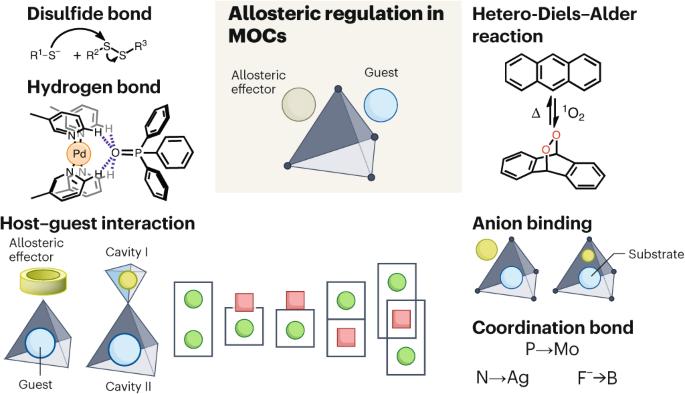Allosteric regulation in metal–organic cages
IF 20
0 CHEMISTRY, MULTIDISCIPLINARY
引用次数: 0
Abstract
Synthetic molecular systems with allosteric regulation capabilities find applications in purification, sensing, molecular delivery and catalysis. Allosteric regulation, often observed in enzymes, involves the binding of an effector at an allosteric site, which results in the modulation of the function of an active site. Recent efforts have produced synthetic systems that exhibit allostery. Metal–organic cages (MOCs) offer a versatile platform for this purpose due to their three-dimensional structures and simple preparation through self-assembly, enabling the incorporation of multiple binding sites within a single structure. Their structural diversity, tunable cavity sizes and functional adaptability allow effective encapsulation of various guest molecules. Allosteric effectors can serve as chemical triggers to induce structural changes in MOCs through reversible post-assembly modifications, using dynamic covalent bonds or intermolecular interactions. Here we highlight recent advances in using MOCs for allosteric regulation, focusing on design principles, applications and future challenges in this emerging field. Synthetic molecular systems exhibiting allosteric regulation are used in purification, sensing, delivery and catalysis. Metal–organic cages provide a versatile platform for allosteric regulation due to their structural diversity and tunable cavities. This Review discusses recent advances in allosteric regulation with metal–organic cages, emphasizing design principles, applications and future challenges.

金属有机笼的变构调节
具有变构调节能力的合成分子系统在纯化、传感、分子传递和催化等领域得到应用。变构调节通常在酶中观察到,涉及到在变构位点的效应物的结合,从而导致活性位点功能的调节。最近的研究已经产生了具有变构性的合成体系。金属有机笼(moc)由于其三维结构和通过自组装的简单制备,可以在单个结构中结合多个结合位点,因此为这一目的提供了一个多功能平台。它们的结构多样性,可调节的腔大小和功能适应性允许有效封装各种客体分子。变构效应物可以作为化学触发器,通过动态共价键或分子间相互作用,通过可逆的组装后修饰诱导moc的结构变化。在这里,我们重点介绍了使用moc进行变构调节的最新进展,重点介绍了这一新兴领域的设计原则、应用和未来挑战。表现出变构调节的合成分子系统被用于纯化、传感、传递和催化。金属有机笼由于其结构多样性和可调谐的腔体,为变构调节提供了一个通用的平台。本文综述了金属有机笼变构调节的最新进展,强调了设计原则、应用和未来的挑战。
本文章由计算机程序翻译,如有差异,请以英文原文为准。
求助全文
约1分钟内获得全文
求助全文

 求助内容:
求助内容: 应助结果提醒方式:
应助结果提醒方式:


